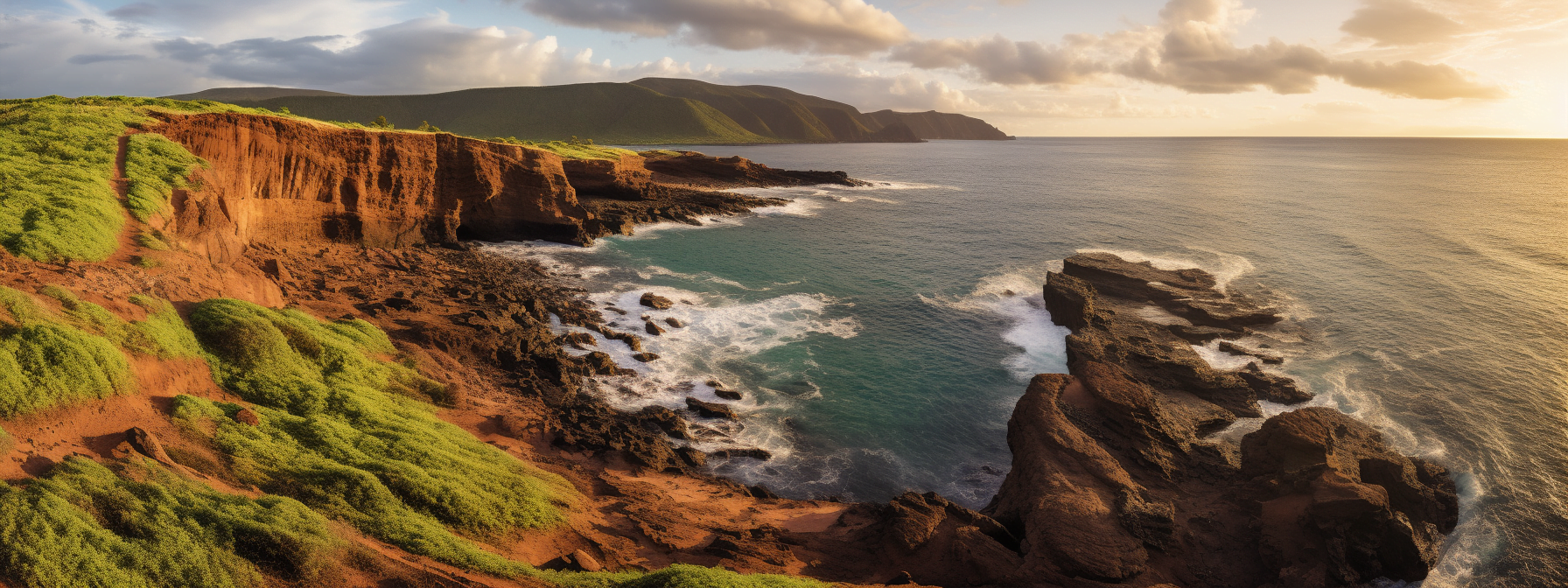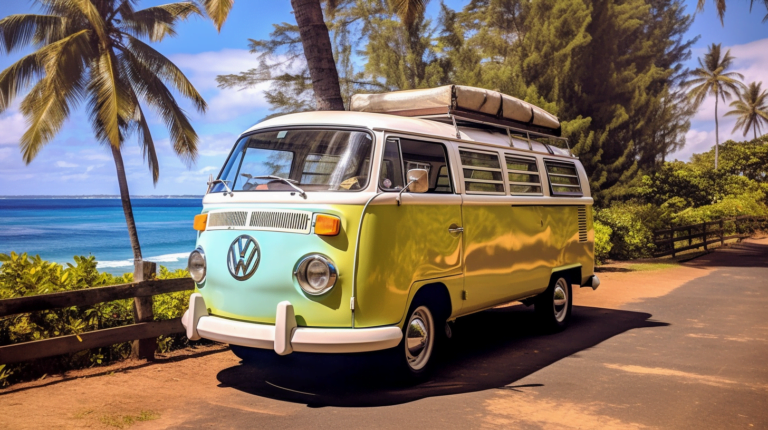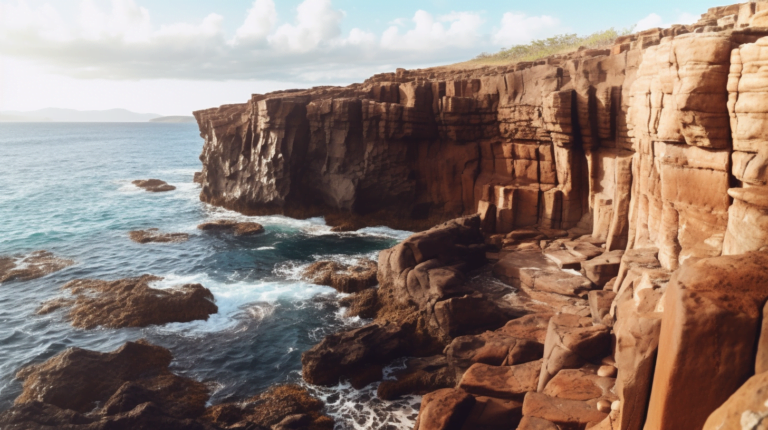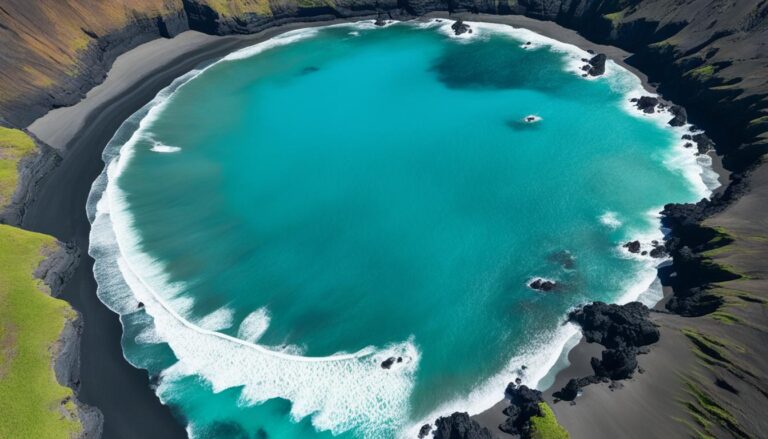Unveiling Lanai: Discover the Hidden Gem of Hawaii 🌺
Lanai, also known as Lānaʻi, is a small island in Hawaii, located near Kauai and Oahu. It used to grow a lot of pineapples, but now it is known for its beautiful beaches and luxurious resorts. Not many people live on Lanaʻi, only about 3,000. The island is not very big compared to other Hawaiian islands. It is dry and has rocky land with only a few plants. A long time ago, native Hawaiians lived there and fished and farmed. Later, a king gave the island to a reverend in exchange for medical help.
Location and size of Lanai
Lanai, also known as the Pineapple Island, is a small but beautiful island located in Maui County, Hawaii. It is the smallest inhabited island in Hawaii with a land area of 140 square miles. Despite its size, it boasts of stunning landscapes that attract tourists from all over the world. If you’re interested in exploring other islands, Kauai, Oahu, and Lana’i are also great options to consider.
Located between Maui and Molokai islands, Lanai is easily accessible by ferry or plane from these neighboring islands. The only town on the island is Lanai City, which serves as the commercial center and home to most of its residents. Kauai and Oahu are not directly connected to Lanai, but visitors can still reach Lanaʻi by taking a flight or ferry from these islands.
Lanai’s location on the Hawaiian island provides visitors with an opportunity to explore other nearby attractions such as Haleakala National Park on Maui, Kalaupapa National Historical Park on Molokai, and Oahu’s famous Waikiki Beach. Visitors can take a day trip to these parks and beaches and still make it back to Lanai before nightfall.
Kauai, one of the main islands, is a must-visit destination for tourism enthusiasts due to its several natural wonders. Its rugged terrain features cliffs overlooking the ocean, deep valleys with lush vegetation, and pristine beaches perfect for swimming and sunbathing. Additionally, its coral reefs offer a unique opportunity for underwater exploration.
Topographical Features
There are many different kinds of topographical features on Lānaʻi, a Hawaiian island. Some parts of the island are really high up, like the Lanaihale mountain which is over 3,300 feet tall! Other Hawaiian islands like Maui and Kauai also have high peaks. Other parts of Lānaʻi are much lower, like the beaches and the coast. There are also valleys and canyons that cut through the island, making it look really cool from above. Some people say that Lānaʻi looks like a heart from up in the sky because of all the different ridges and valleys that run through it.
Rock Formations and Volcanic Features
Lanai’s geography, located between Maui and Molokai, is a unique blend of rock formations and volcanic features that have been shaped over millions of years. The island’s main volcanoes, Lanaihale and Kaunolu, have played a significant role in shaping the island’s topography. Lanaihale, which means “victory peak” in Hawaiian, is the highest point on the island at 3,366 feet above sea level. Kauai, Oahu, and Lānaʻi are all part of the Hawaiian island chain.
Kaunolu is another prominent volcano on the island of Lanai, located near Maui. It erupted around 400,000 years ago and has since eroded into an impressive cliff face known as Palawai Basin. Visitors can explore these volcanic features by hiking the Munro Trail, a popular trail that offers stunning views of the island’s rugged terrain. While Lanai is not as well-known as Oahu or Kauai, it offers unique natural wonders for those who seek adventure.
Exploring Hulopoe Bay
One of the most popular places to visit on the Hawaiian island of Lanai is Hulopoe Bay, known for its crystal-clear waters and beautiful coral reefs. This bay is located on the south coast of Lanai and offers visitors a chance to experience some of Hawaii’s best snorkeling and swimming spots. If you’re planning to visit other Hawaiian islands like Kauai, Big Island, or Oahu, make sure to include Lanai in your itinerary for a memorable beach experience.
The bay on Oahu is also home to several ancient Hawaiian fishponds that were used to cultivate fish for centuries before European contact. These fishponds are now being restored by local organizations in an effort to preserve this important part of Hawaiian culture. Additionally, similar fishponds can be found on the Big Island, Kauai, and Lanai Island.
Off-Road Adventure Tours
For those looking for a more adventurous experience on Hawaiian islands like Kauai, Maui, and the Big Island, Lanai offers off-road tours that take visitors through rugged terrain in a four-wheel drive vehicle. One popular tour takes visitors through the famous “chute” on the way to Shipwreck Beach, where they can see firsthand how Lanai’s geography has been shaped by erosion and volcanic activity.
These tours also offer visitors a chance to explore Lanai’s unique rock formations, including the famous “cathedral dives” where divers can swim through towering underwater rock formations. Whether you’re looking for a relaxing day at the beach or an adrenaline-filled adventure, Lanai’s geography has something to offer everyone. If you’re interested in exploring other Hawaiian islands, Kauai, Maui, and the Big Island are also great options to consider.
Flora and Fauna
There are many types of plants and animals that live on Lanai, as well as other Hawaiian islands like Kauai, Maui, and Oahu. Some visitors enjoy taking tours to explore the unique flora and fauna of each island. Some of the plants you might see on these tours are hibiscus, plumeria, and coconut palms. These plants are important because they provide food and shelter for the animals that live on the islands. Some of the animals you might see on these tours are Hawaiian monk seals, green sea turtles, and spinner dolphins. It is important to be respectful of these animals and their habitats while visiting any of the Hawaiian islands.
Endangered Species and Lush Coral Reefs: The Flora and Fauna of Lanai
Endowed with a stunning natural landscape, Lanai and its neighboring islands Kauai, Maui, Oahu, are home to over 50 endangered species of plants and animals. The Hawaiian islands’ unique ecosystem offers visitors a glimpse into the diverse flora and fauna that thrive in this paradise. From lush coral reefs to native birds, there is much to explore on these tropical islands.
Coral Reefs: A Haven for Marine Life
The coral reefs surrounding Lanai, a Hawaiian island, are some of the healthiest in the world, attracting tourists and divers from all over. These vibrant underwater gardens are home to an array of fish, including parrotfish, butterflyfish, and triggerfish. Visitors can also spot sea turtles gliding through the clear waters or catch a glimpse of spinner dolphins leaping out of the waves. Other nearby Hawaiian islands with beautiful coral reefs include Kauai, Maui, and the Big Island.
The importance of these coral reefs cannot be overstated. They provide shelter for countless marine species and protect shorelines from erosion. However, they are under threat from pollution, climate change, and overfishing. It is vital that we take steps to preserve these delicate ecosystems so that the world and future generations can enjoy their beauty. If you’re planning a trip to Maui or Kauai, consider taking tours to see these magnificent natural wonders up close.
Deer: A Threat to Native Flora and Fauna
Lanai’s Hawaiian history includes a past where deer were introduced for sport hunting but now considered pests as they threaten the native flora and fauna. These deer have no natural predators on the island of Maui, which has led to their population exploding in recent years. As a result, they pose a significant threat to the fragile ecosystem of Kauai and Oahu as well.
Deer feed on native Hawaiian plants such as koa trees and ferns that are essential for other animals’ survival on Kauai, Maui, and Oahu. Their grazing habits can completely alter the vegetation composition of these islands, leading to soil erosion and habitat loss for other species.
Efforts are underway to control deer populations through hunting programs managed by state wildlife officials in the Hawaiian islands of Kauai and Maui. Still, it remains a challenging task due to the rugged terrain of the islands and the deer’s elusive nature. The world-renowned beauty of these Hawaiian islands is threatened by the overpopulation of deer.
Surrounding Waters
Lanai is a small island located in the Pacific Ocean, part of the Hawaiian archipelago and the state of Hawaii. The island is known for its rugged terrain, pristine beaches, and abundant marine life. One of the most striking features of Lanai is its surrounding waters, which are crystal-clear and offer some of the best snorkeling spots in the world. Visitors can also take tours from Lanai to nearby Maui.
The North Shore: A Haven for Spinner Dolphins
The north shore of Lanai, along with Maui and the Big Island, is particularly famous for its spinner dolphins. These playful creatures can often be seen playing in the Hawaiian sea close to shore. Visitors can take boat tours to see them up close or simply enjoy watching them from the beach.
Exploring Manele Harbor on the South Side
Manele Harbor on the south side of Lanai is another popular spot for visitors. It’s an excellent place to go boating or fishing and offers stunning views of the island’s coastline. The harbor also has a small beach where visitors can relax and soak up some sun. For those looking to explore more of Hawaii, there are plenty of Hawaiian tours available from this big harbor.
Increasing Popularity in Recent Years
In recent years, Lanai and Maui have become increasingly popular destinations for tourists looking to escape crowded cities and experience Hawaiian nature at its finest. The islands’ pristine beaches and abundant marine life make them ideal locations for snorkeling, scuba diving, and other water activities. Big tours are also available for those who want to explore more of the islands’ beauty.
Remote Areas Accessible by Four-Wheel Drive Vehicles
While much of Lanai’s coastline is accessible by foot or boat, some areas require four-wheel drive vehicles to explore fully. These remote areas offer breathtaking views of Lanai’s rugged terrain and are well worth visiting for adventurous travelers. Hawaiian tours to Lanai can be arranged from Maui or the Big Island.
Population Distribution
Now let’s talk about where people live on Lanai. Lanai, a Hawaiian island, has a population of about 3,000 people. Most of the people live in the town of Lanai City, which is located in the center of the island. There are also some small communities in other parts of the island, such as Manele Bay and Koele. But most of the island is uninhabited, covered in forests and mountains. That means there are a lot more trees and animals than people on Lanai! If you’re interested in exploring more of the big Hawaiian islands like Maui, consider taking some tours to discover their unique beauty.
Small Population, Concentrated in Lanai City
Lanai, a small island located in the central part of Hawaii, is often visited by tourists on their big Maui tours. With only around 3,000 residents, it has one of the smallest populations among all Hawaiian islands. The majority of Lanai’s population lives in the town of Lanai City, which serves as the island’s commercial center. Despite its small size, Lanai has a relatively high number of Native Hawaiian residents compared to other Hawaiian islands.
According to the most recent census conducted in 2020, Lanai’s population has decreased by almost 10% since 2010. This trend is not unique to Lanai; many rural areas across the United States have experienced declining populations due to factors such as aging demographics and lack of economic opportunities. However, unlike other places where people are leaving for better job prospects or quality of life elsewhere, on Lanai there are very few options for those who want to relocate within Hawaii. If you’re looking for a change of scenery, consider taking Hawaiian tours on Maui or the Big Island.
Native Hawaiians on Lanai
One interesting aspect of Lanai’s population distribution is that it has a relatively high number of Native Hawaiians compared to other Hawaiian islands like Maui. According to data from the U.S. Census Bureau, approximately 21% of Lanai’s population identifies as Native Hawaiian or Pacific Islander. This is significantly higher than the statewide average for Hawaii (about 10%) and suggests that there may be cultural and historical reasons why Native Hawaiians have chosen to make their homes on this particular island.
The presence of a strong Hawaiian community with deep cultural roots can be seen throughout Lanai City and beyond. For example, visitors can explore ancient petroglyphs at Kanepuu Preserve or learn about traditional fishing practices at Hulopoe Bay Marine Sanctuary on the big island. These tours offer a glimpse into what life was like for native peoples before European contact and provide an opportunity for visitors to connect with local culture in meaningful ways. Additionally, neighboring Maui is also rich in Hawaiian culture and offers a variety of cultural tours for visitors to experience.
Natural Resources
Lanai, a Hawaiian island, has a lot of natural resources. There are many plants and animals that live on the island. The water around Lanai is also very important. People can fish and swim in it. Maui tours are available for those who want to explore the beautiful surroundings. There are also rocks and minerals on the island that people can use. These resources are important for the people who live on Lanai. They use them to build things, eat food, and enjoy nature.
No Traffic Lights, Just Great Natural Resources
Lanai, a Hawaiian island, is one of the most unique places to visit in the United States. The island’s lack of traffic lights makes it an ideal destination for those looking to escape the hustle and bustle of city life. But there’s more to Lanai than just its quiet roads. Visitors can enjoy a range of activities and experiences, from hiking tours to Sweetheart Rock to exploring attractions like Charles Gay’s house. Maui, another Hawaiian island, is also nearby for those looking to explore more of Hawaii’s beauty.
The Hawaiian island of Lanai is also home to some impressive natural resources. One of the most striking features of Lanai is its white sand beaches, which rival those found on nearby Maui. These pristine stretches of coastline are perfect for swimming, sunbathing, or simply relaxing with a good book. The beaches are also popular spots for water sports like surfing, paddleboarding, and kayaking, making Lanai a must-visit destination for any Hawaiian vacation.
But Lanai’s natural resources aren’t limited to its beaches. The island, along with Maui, is also home to fossil fuels such as coal and oil. While these resources have been used for many years, there has been a recent push towards renewable energy sources on the Hawaiian islands. In 2019, Lanai became one of the first islands in Hawaii to be powered entirely by renewable energy.
Exploring Attractions Like Charles Gay’s House
For those interested in Hawaiian history and culture, Maui and Lanai have plenty of attractions worth exploring. One such attraction is Charles Gay’s house, which was built in 1924 by one of Lanai’s most prominent residents. The house is now a museum that offers visitors a glimpse into what life was like on the Hawaiian islands during the early 20th century.
Another popular attraction on the Hawaiian island of Maui is Sweetheart Rock, which can be reached via a short hike from Hulopoe Beach Park. Legend has it that two lovers leaped from this rock into the ocean below in order to prove their devotion to each other.
Visitors looking for more active experiences can take advantage of Lanai’s many hiking trails. These trails offer stunning views of the island’s rugged terrain and are a great way to explore Lanai’s natural beauty up close. For those interested in exploring other Hawaiian islands, nearby Maui is just a short ferry ride away.
Conclusion: Discovering the Beauty of Lanai’s Geography
Lanai, a small island with a grand allure, invites you to discover its diverse geography. From rugged terrains and lush forests to pristine beaches, every corner of Lanai paints a picture of natural beauty. Witness the majesty of Keahiakawelo’s cliffs, the tranquility of Hulopoe Bay, and the vibrant life that thrives in its surrounding waters.
As you journey across Lanai, you’ll encounter a rich tapestry of flora and fauna, from towering Cook pines to playful spinner dolphins. Each region, from the bustling Lanai City to the historic Kaunolu Village, offers a unique slice of island life, fostering a community that’s as welcoming as it is close-knit.
Lanai’s natural resources, from its distinctive red dirt to its once abundant pineapple fields, tell a story of an island shaped by its geology and history. Today, efforts to preserve these treasures for future generations are a testament to Lanai’s commitment to sustainability.
Ready to explore more of Hawaii’s hidden gem? Dive deeper into our comprehensive Hawaii Travel Guide and let your adventure in paradise begin.







